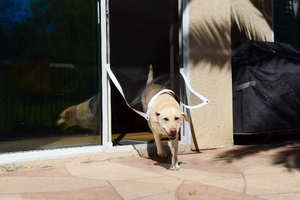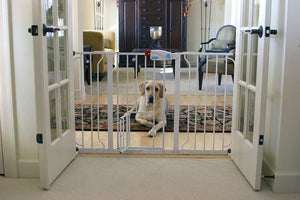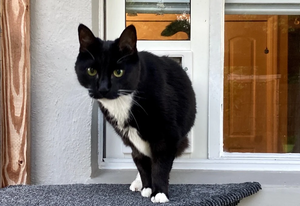How to Install an Invisible Fence
What is an Invisible Fence?
An invisible dog fence is an underground fencing system that uses a small electrical charge to create a hidden boundary around the yard for your pet. For neighborhoods that prohibit building fences or for pet owners who don’t want to ruin a view or certain landscaping, invisible dog fence systems are viable options for meeting your needs while keeping your dog safe in the yard. But the real question is, will an invisible fence work?
 When the dog approaches the boundary of the pet containment system, an auditory beeping noise goes off, giving them a warning signal to retreat from the fence to avoid a light shock. Your dog wears a receiver collar that picks up radio frequency signals from the fence, setting off a slight shock from the collar receiver when they attempt to pass the boundary. The shock is not meant to hurt them, but rather gives off a slight feeling of discomfort (like static shock) to keep them from going past the boundary. After a few days of diligent static correction training, most dogs understand not to go too close to the fence.
When the dog approaches the boundary of the pet containment system, an auditory beeping noise goes off, giving them a warning signal to retreat from the fence to avoid a light shock. Your dog wears a receiver collar that picks up radio frequency signals from the fence, setting off a slight shock from the collar receiver when they attempt to pass the boundary. The shock is not meant to hurt them, but rather gives off a slight feeling of discomfort (like static shock) to keep them from going past the boundary. After a few days of diligent static correction training, most dogs understand not to go too close to the fence.
Invisible Fencing Facts
Prior to buying an invisible fence, it is important to make a note of some of the common features:
- In the event of a power outage, the fencing will not work because it runs on electricity.
- It does not prevent other animals from entering your yard.
- Some dog owners are hesitant to install a dog invisible fence because they are afraid that they will interfere with electronic pet doors or their collar keys, but all electronics will still function properly!
- If you live on a large property, you can make the invisible fence as large as you want for not much more than the original cost or hassle. You just need to provide extra wiring.
- Invisible fence cost: typically between $950 and $1500 (dependent on wire quality, collar cost, voltage meter quality, the size of your property the invisible fence brand, and training). Some online research will quickly reveal the best electric dog fence for your needs.
Steps to Install an Invisible Fence
It is extremely important to do thorough planning prior to purchasing and installing a dog electric fence. The following steps are here to help you make your decision with accuracy and thoroughness. Keep reading to learn more about how to install an invisible fence for dogs!
Call 811
If you did not know already, calling 811 in the United States directs you to a state service that gives you the necessary details about any buried utilities that may be underneath your property. It is crucial to call this number prior to determining where in your yard you intend to install the invisible fence system, as it is imperative that you do not lay wires within 10 feet of any other utilities. Laying your wires too close to other utility lines can cause interference with your fence.
Design a Layout
Make a layout of where you want the invisible fence boundaries to be located. If your yard does have any utility lines, it is important that your wires will be at least 10 feet away from the utility lines if they are running parallel. Look for any obstacles that might be a hindrance to the wires and adjust accordingly. Once you feel confident with the proposed layout, determine where the transmitter will be located. Inside a garage is the best option, as it is the least fire hazardous. Once you’ve determined the appropriate location, measure the perimeter to determine how much underground wire you’ll need. The invisible fencing packages indicate how much wire is included, so it’s best to do this prior.
Testing the Wires
Most kits include training flags for the purpose of laying out the wires as well as showing the pet the area that they cannot cross. Prior to digging the trench, lay down the flags where you intend to place the wires. Be sure that the wires are above ground and lined up along the flag. This will let you know if you have enough wiring. Once this is done, plug the transmitter into a GFCI wall outlet and connect the ends of the fence wires to it. Turn on the system.
To test the fencing, walk around the perimeter holding the dog collar. This process will ensure that the radio frequency of the collar is in sync with the fence. When you get close enough to the fencing, the collar will make an auditory beeping noise, warning you that you are too close. Do so around the entire perimeter of the wireless dog fence, making sure that you do not pick up a signal once you are inside. If a signal is picked up, you will need to adjust the wiring layout.
Bury the Wires
In order to bury the wires, you will need to use a spade or similar digging tool to carve out a 1” ‒ 3” trench in the ground. Lay the wires. Test the wiring again using the same method you did before; then use the existing soil to bury it. If you are burying the fence under dirt or gravel, you will need to install a waterproof PVC pipe and run the wires through it to protect them. If you need to run the lines under concrete, you will need a circular saw fitted with a masonry blade and patching compound suitable for the surface you want to cross. Once these steps are completed and you have ensured that the collar is working correctly, you can begin dog training.
Training
Leave the flags in place for training purposes, as it will give your dog a visual indicator of the pet fence boundary. Training with an invisible fence collar will take at least two days, so it is recommended to allot time during a weekend so that your dog has the optimal amount of time to learn and remember. To start, walk around the perimeter every hour or so with the dog on a leash.

When the collar beeps, pull them away and tell them to sit, rewarding them with a treat for moving away from the fence. Do so at different points of the boundary so that they know the beeping will occur in more than one spot. Then do so with the small shock as well, rewarding them with heavy praise and treats. On the second day of training, try letting your dog test the perimeter without your assistance, but leave a leash on them to grab just in case. Make sure not to let them run past the invisible fence, or else you will have to start training over again. Different training techniques will work for different dogs, but we recommend being patient and kind as they adjust to the newness of the fence.
Don’t leave the dog unattended in the backyard until you are confident that they are comfortable with the boundaries. If you have to leave, keep your pet inside or on a long enough leash that will prevent them from getting close to the boundaries while giving them enough space to remain comfortable. Leaving the flags in place is also a good idea if you feel that your dog is not 100% confident with the boundaries.
Battery Life
The batteries last 3 ‒ 6 months. Most collars have a low battery indicator, but be aware of typical battery life just in case.
References:
https://www.petplaygrounds.com/how-much-does-a-wireless-invisible-fence-cost/
https://www.lowes.com/projects/other-activities/install-an-electronic-dog-fence/project




